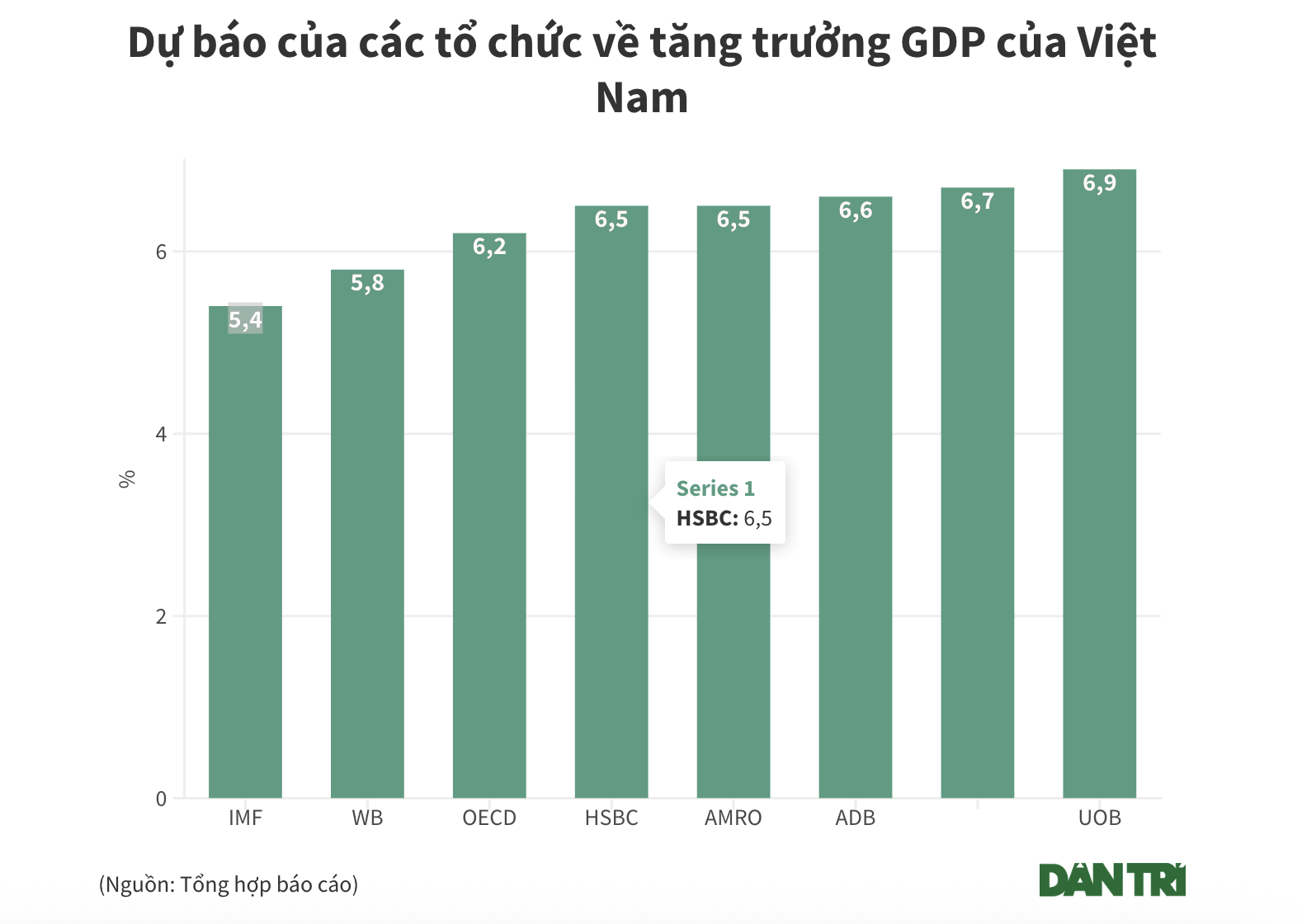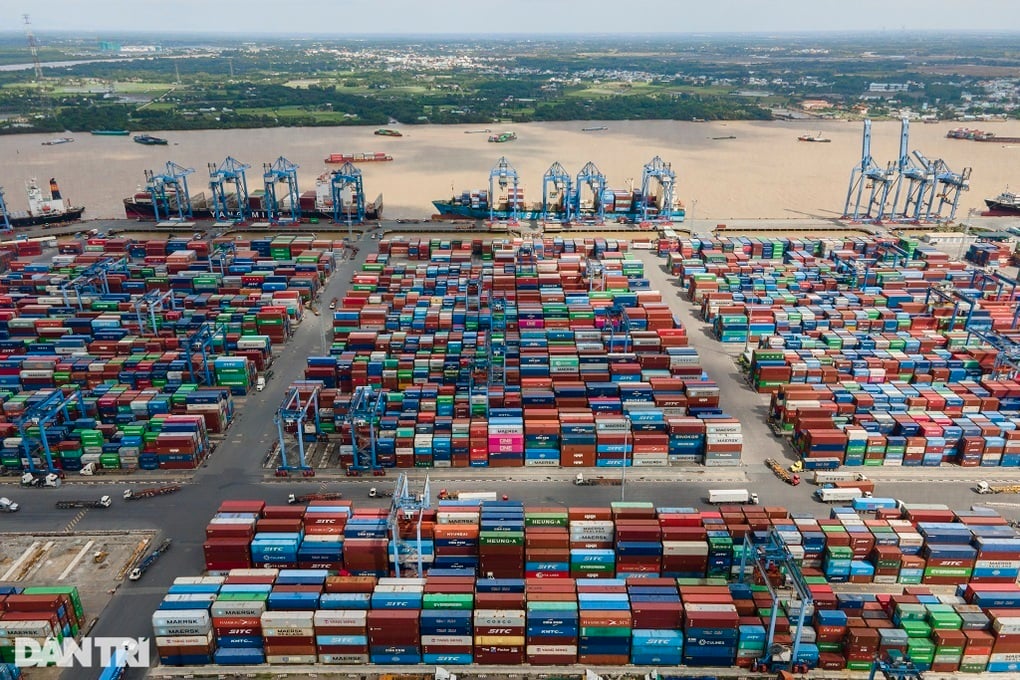Vietnam's economy is flourishing
United Overseas Bank (UOB) has just raised its forecast for Vietnam's GDP growth in 2025 from 6% to 6.9%, after the second quarter economy grew beyond expectations and tariff negotiations with the US achieved positive results.
According to the General Statistics Office ( Ministry of Finance ), GDP in the second quarter increased by 7.96%, far exceeding the forecasts of Bloomberg (6.85%) and UOB (6.1%). As a result, growth in the past 6 months reached 7.52%, the strongest increase in the first half of the year since data was available in 2011.
UOB said that a surge in exports before the US tariffs were the main driver of the economic recovery, with first-half turnover up 14% year-on-year. Following the favorable outcome of trade negotiations with the US, the bank said that “the most stressful period is over” and forecasted exports to increase moderately in 2025.
Specifically, exports to the US are forecast to increase by 5%, lower than the 23% increase in 2024 but much higher than the 20% decrease in the previous estimate. For other markets, the expected increase is 10%, almost equivalent to 2024 (11.3%). Overall, exports in 2025 may increase by 8.5%, lower than the 14% increase last year.
Based on these factors, along with the positive impact from manufacturing and FDI inflows, UOB adjusted its forecast model, raising Vietnam's GDP growth by 0.9 percentage points.
UOB currently forecasts GDP growth of about 6.4% in the third and fourth quarters, with FDI disbursement for the whole year reaching about 20 billion USD. Meanwhile, the Government 's target is growth of over 8%. Finance Minister Nguyen Van Thang commented that in the context of many fluctuations in the global economy, Vietnam is still "going against the tide, achieving positive results", and achieving a minimum growth rate of 8% in the last 6 months of the year is feasible.
The Organization for Economic Cooperation and Development (OECD) has a more cautious view. In its Vietnam Economic Report 2025 released in mid-June, the organization stated that Vietnam has made important long-term strides.
According to the OECD, Vietnam is an export-oriented economy, making it vulnerable to external shocks. Escalating trade tensions and policy uncertainty are major risks that could reduce the attractiveness of investing in Vietnam.
The OECD assessed that Vietnam's economy has recovered impressively after the pandemic, with GDP growing by 7.1% in 2024, exceeding the set target. The main driver came from stable domestic consumption, when household spending increased by 6.7% thanks to improved income and employment.
However, growth is forecast to slow to 6.2% in 2025 and 6% in 2026, due to fluctuations in global trade. New tariffs from the US, affecting about a third of Vietnam's exports, are expected to significantly dampen trade prospects. It is estimated that the effective tariff rate on Vietnamese goods exported to the US could increase by about 3 percentage points...
In the long term, the OECD believes that improving labor productivity is a key factor for Vietnam to realize its goal of becoming a high-income country by 2045. The golden population period is gradually passing, so growth needs to rely more on the efficiency of capital and labor use.
Although Vietnam’s labor productivity has grown faster than many regional economies, it remains low in absolute terms. A major bottleneck is the weak linkages between foreign and domestic enterprises. As of 2020, nearly 48% of export value came from imported inputs, indicating that most FDI enterprises still operate separately from domestic supply chains.
Many international organizations are optimistic about Vietnam's economy (Photo: Nam Anh).
The ASEAN+3 Macroeconomic Research Office (AMRO) forecasts Vietnam's GDP growth at 6.5% in 2025 and 6.2% in 2026. However, the organization also notes that the outlook for the entire ASEAN+3 region depends heavily on US trade policies.
From another perspective, the World Bank (WB) also revised down its forecast for Vietnam's GDP growth to 5.8% for 2025 and 6.1% for 2026. The WB said the adjustment reflects the impact of increased trade barriers, weakening global economic prospects, as well as declining confidence in the areas of consumption, investment, and exports.
The International Monetary Fund (IMF) forecasts Vietnam’s GDP growth to reach 5.4% in 2025 and decrease to 4% in 2026. According to the IMF, the Asian region, especially ASEAN, is being significantly impacted by the new US tariff policy. However, the IMF believes that some countries, including Vietnam, can still take advantage of the opportunity to restructure their trade networks and strengthen their position in the global supply chain.
According to the Asian Development Bank (ADB), Vietnam's GDP is expected to grow by 6.6% in 2025, and reach 6.5% in 2026. This forecast was made before the US announced new tariffs on April 2.
3 main pillars to promote economic development
Associate Professor Dr. Nguyen Huu Huan, Lecturer at Ho Chi Minh City University of Economics (UEH), said that in the past, to achieve 1% GDP growth, Vietnam needed 3% credit growth. However, in 2024, this rate has decreased to about 2%, showing that the efficiency of credit capital use has improved.
With a credit growth plan of 16% and GDP of 8% in 2025, i.e. maintaining a credit ratio of 2% for every 1% of GDP, Mr. Huan said this is a challenging target. Especially compared to the period of 2018-2022, when the economy - specifically real estate - accounted for a large proportion of credit, causing the economy to need a higher amount of capital to achieve the same growth rate.
The year 2024 marks an important shift, in which credit flows are prioritized for production - a sector with higher capital efficiency, instead of pouring into real estate or less efficient areas. This helps GDP growth to be less dependent on credit scale, and the ratio of 2% credit for 1% GDP growth becomes more feasible.
Exports still play a key role in economic growth (Photo: Hai Long).
However, according to Mr. Huan, to achieve the growth target of 8% this year, the prerequisite is that credit capital must continue to be allocated reasonably into highly effective areas such as production and business.
He also emphasized that the three main pillars driving economic growth are exports, public investment and domestic consumption, in which exports still play a key role. This year's export outlook will depend on the global trade environment, especially the US tariff policy. If Vietnam maintains a stable position and avoids tariffs, exports will have great room for growth.
In addition, FDI inflows could increase significantly as international corporations seek to diversify their supply chains, avoiding risks from markets such as China or Mexico. At that time, Vietnam has the opportunity to attract more investment, while reducing pressure on the exchange rate, which is one of the major macro risks this year.
In short, to realize the 8% growth target, Vietnam needs to make good use of positive signals from the international market, maintain an effective credit orientation, while promoting public investment disbursement and stimulating domestic consumption.
From the perspective of domestic economic organizations, Mr. Bui Thanh Trung - Senior Deputy General Director of Thien Viet Securities Joint Stock Company (TVS) - in a recent event commented that Vietnam's economy is recovering strongly and has many positive signals.
Citing data from the General Statistics Office, Mr. Trung said that GDP growth in the past 6 months reached 7.52%, of which the first quarter reached 6.93% and the second quarter skyrocketed to 7.96%. According to him, this is proof that Vietnam's recovery from the COVID-19 pandemic is sustainable. Vietnam continues to be one of the countries with high growth rates in the world.
He assessed that Vietnam is controlling inflation well. With the annual inflation target ranging from 4 to 4.5%, the average for the first 6 months of the year was only around 3.6%, which is completely under control. He believes that Vietnam can keep inflation below the 4% threshold this year.
Another bright spot is credit. Credit growth in the first half of the year reached 8.3%, while deposit growth reached 6.1% - the highest level in the past 5 years since the Covid-19 pandemic. By the end of 2025, credit growth is expected to be 16-17%.
Mr. Trung said that with the current credit growth momentum, if GDP in the last 6 months of the year reaches about 8.5%, the growth target of 8% for the whole year of 2025 is completely feasible.
Dantri.com.vn
Source: https://dantri.com.vn/kinh-doanh/nhieu-to-chuc-quoc-te-nang-du-bao-tang-truong-gdp-cua-viet-nam-20250710074425806.htm
































![[Photo] Gia Lai provincial leaders offer flowers at Uncle Ho's Monument with the ethnic groups of the Central Highlands](https://vphoto.vietnam.vn/thumb/1200x675/vietnam/resource/IMAGE/2025/7/9/196438801da24b3cb6158d0501984818)






































































Comment (0)